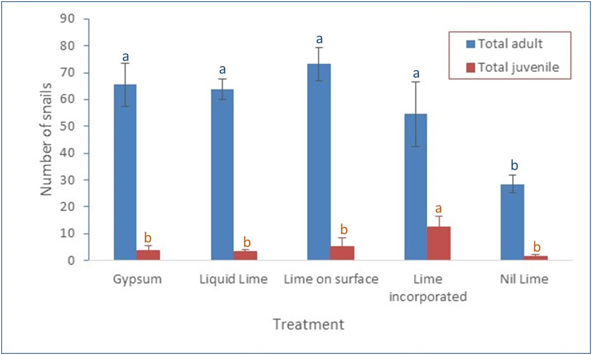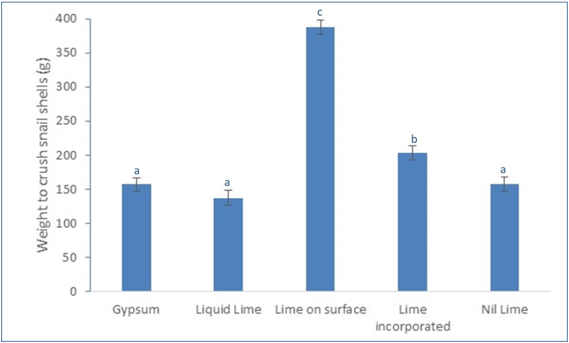Determining the effect of lime on small pointed (conical) snail fecundity and shell strength
Determining the effect of lime on small pointed (conical) snail fecundity and shell strength
Author: Svetlana Micic, Gerry Skinner, Tony Dore, Carlos Babativa-Rodriguez | Date: 10 Feb 2020
Key messages
- Small pointed snails in paddocks with lime applied in granular form to the topsoil will have stronger shells and increased fecundity than snails from similar un-limed paddocks.
- In limed paddocks, snail management options such as baiting need to be considered.
- If soil acidity is addressed so that granular lime is not present on the soil surface, then there is little impact on the shell strength or fecundity of snails.
Introduction
Trials done in South Australia suggest lime affects the fecundity of round snails (vineyard snail Cernuella virgata andwhite Italian snail Theba pisana) by increasing the number of eggs laid and subsequent snail survival (M. Nash pers. comm).
Surveys done by The Department Primary Industries and Regional Development (DPIRD) found that in WA round snails tend to be found in areas with alkaline soils while small pointed snails are found on any soil type.
Snails obtain the calcium required for their shells from soil and rock containing calcite (CaCO) or from the calcium and carbonate ions in living or dead plant material.
Anecdotal farmer observations in Western Australia suggest small pointed (conical) snail numbers are increasing with the addition of lime. Growers requested research to determine whether incorporating lime or using alternatives to granular lime could decrease the snail problem.
Aim
Determine the effect of different types of lime application as per farm practices on snail fecundity and shell strength.
Method
Soil that was deemed acidic (pH 4.8) was collected from South Stirling in WA. A comprehensive soil test by CSBP was undertaken and the following treatments were implemented as acidity mitigation measures (C. Gazey pers. comm):
1. Gypsum applied at a rate of 2.7t/ha
2. Liquid lime applied at a rate of 100L/ha
3. Granular lime applied on soil surface at a rate of 2t/ha
4. Granular lime incorporated at a rate of 2t/ha
5. Nil lime
Soil was placed into boxes measuring 270 X 55 X 35mm so that boxes were ¾ full. Each box had a firm fitting mesh lid. The boxes were placed in a randomised block design on two tables in the shade house. To each tote box 100 juvenile snails (measuring ~4mm) were added along with 50 clover seeds and 30g of stubble. The germinated clover provided a food source for snails.
Boxes were checked weekly to fortnightly to ensure they were not drying out and watered over summer using overhead irrigation. Snails were placed in boxes for a duration of 13 months, after which time snails on the soil surface were removed and the soil sieved and snails counted.
Snail strength measure machine
A lever system was used to determine the weight required to crush a snail shell. Each snail was placed on its side onto digital scales capable of weighing up to 620g in mass. A bucket was placed at one end of the lever with the other end the lever located above the snail. As the bucket was filled with sand, the lever moved down towards the snail. The weight of sand required for the lever to fracture the snail shell was measured.
Pre-treatment assessment of snail strength
Using mature snails measuring 8.8-10.1mm, 100 dead and 50 live snails from each treatment were crushed using the snail strength machine to determine if shell strength differed between dead and live snails and the range in shell strength within in a single population. Snails were collected from the same location as those used in the trial.
Results and discussion
There was no difference between the shell strength of live snails and dead snails (P<0.05). Therefore, the shell strength of all snails from each treatment whether alive or dead is presented here. The standard deviation was large indicating that shell strength is highly variable in a snail population.
Snails exposed to granular lime incorporated into the soil produced more juveniles (P<0.05) (Figure 1). Lime in this treatment was still evident on the soil surface.
Although not significant, snails in treatments with lime applied directly to the soil surface had three times the number of juvenile snails compared to the control and 1.5 times as many juveniles, on average, as the gypsum and liquid lime treatments.

Figure 1. Average number of juvenile and adult snails ± SEM (standard error of the mean) in the five different treatments. Letters indicate significant differences (P<0.05) within categories (adult or juvenile).
Snail numbers declined in all treatments from the start to the end of the trial (Figure 1). This is possibly due to snails falling from lids when cages were opened and/or overlooking snails during recapture.
Snails exposed to lime on the soil surface or to incorporated lime had the strongest shells. On average, snails with access to lime on the soil surface possessed shells that withstood twice the crushing weight of the control (Figure 2).

Figure 2. Shell strength of adults and juveniles exposed to different liming treatments ± SEM (standard error of the mean). Letters indicate significant differences (P<0.05).
Conclusion
Snails with access to granular lime on the soil surface have stronger shells than snails without access to surface granular lime. In this trial, incorporating lime throughout the soil profile left sufficient lime on the soil surface to cause an increase in snail fecundity.
Lime application is essential for ameliorating acidic soils and increasing crop yields. However, if granular lime is to be applied to paddocks that have snails, snail numbers and their shell strength will increase in the season after lime has been applied. Snail mitigation measures such as baiting need to be considered in these paddocks in the cropping season after lime has been applied.
Acknowledgments
The research undertaken as part of this project is made possible by funding from ‘Boosting Grains’.
Contact details
Svetlana Micic
Department of Primary Industries and Regional Development
444 Albany Hwy, Albany, WA, 6330
9892 8591
svetlana.micic@dpird.wa.gov.au
